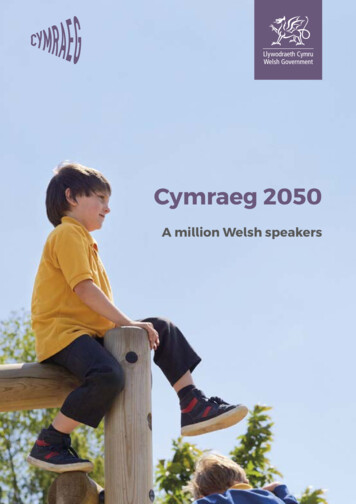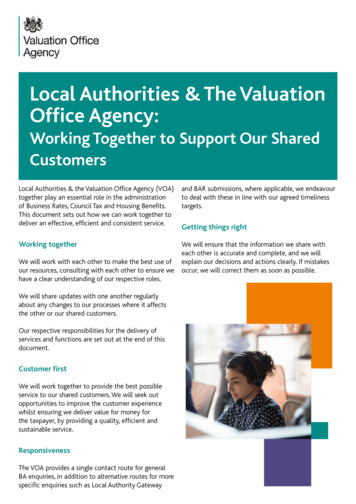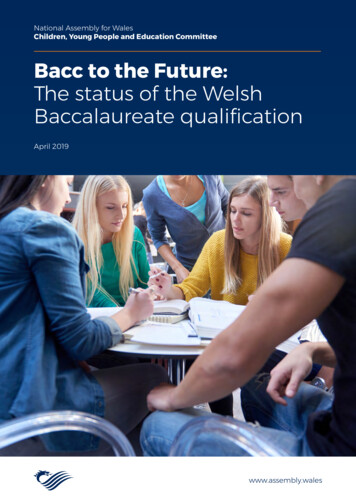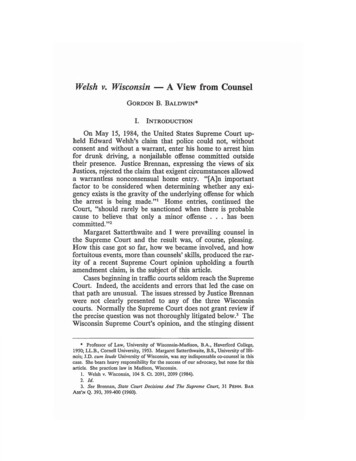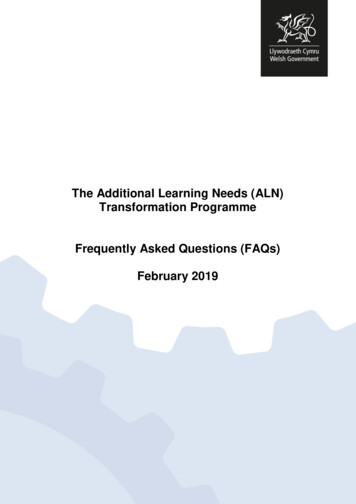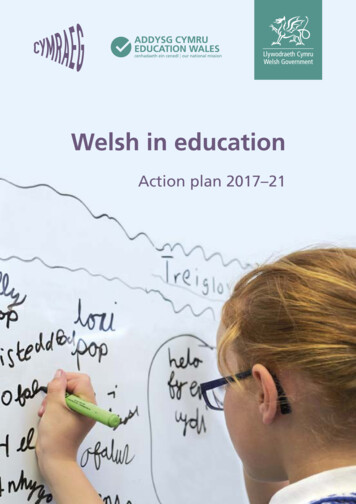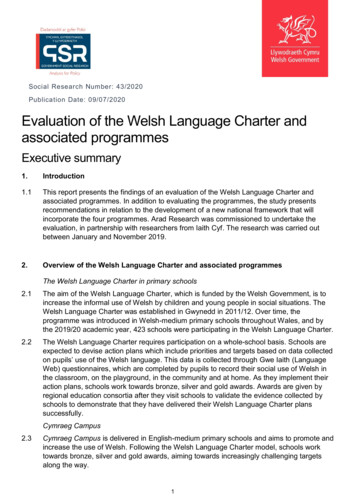
Transcription
Social Research Number: 43/2020Publication Date: 09/07/2020Evaluation of the Welsh Language Charter andassociated programmesExecutive summary1.Introduction1.1This report presents the findings of an evaluation of the Welsh Language Charter andassociated programmes. In addition to evaluating the programmes, the study presentsrecommendations in relation to the development of a new national framework that willincorporate the four programmes. Arad Research was commissioned to undertake theevaluation, in partnership with researchers from Iaith Cyf. The research was carried outbetween January and November 2019.2.Overview of the Welsh Language Charter and associated programmesThe Welsh Language Charter in primary schools2.1The aim of the Welsh Language Charter, which is funded by the Welsh Government, is toincrease the informal use of Welsh by children and young people in social situations. TheWelsh Language Charter was established in Gwynedd in 2011/12. Over time, theprogramme was introduced in Welsh-medium primary schools throughout Wales, and bythe 2019/20 academic year, 423 schools were participating in the Welsh Language Charter.2.2The Welsh Language Charter requires participation on a whole-school basis. Schools areexpected to devise action plans which include priorities and targets based on data collectedon pupils’ use of the Welsh language. This data is collected through Gwe Iaith (LanguageWeb) questionnaires, which are completed by pupils to record their social use of Welsh inthe classroom, on the playground, in the community and at home. As they implement theiraction plans, schools work towards bronze, silver and gold awards. Awards are given byregional education consortia after they visit schools to validate the evidence collected byschools to demonstrate that they have delivered their Welsh Language Charter planssuccessfully.Cymraeg Campus2.3Cymraeg Campus is delivered in English-medium primary schools and aims to promote andincrease the use of Welsh. Following the Welsh Language Charter model, schools worktowards bronze, silver and gold awards, aiming towards increasingly challenging targetsalong the way.1
The ‘Supporting Language Use Project’ (PCAI) / Welsh Language Charter in secondaryschools2.4PCAI is delivered in Welsh-medium secondary schools with the aim of increasing the use ofWelsh amongst young people. PCAI was originally developed by the Welsh LanguageBoard in 2007/08 in order to identify good practice in promoting the social use of Welshamong secondary school pupils. The programme is administered by regional consortia whoprovide a grant of 1000 to secondary schools in order to support projects or activities toincrease the informal and social use of Welsh. Since 2018 there has been a move byconsortia towards implementing the Welsh Language Charter in secondary schools,developing activities and a structure which correspond to the Welsh Language Charter inprimary schools programme.Cymraeg Bob Dydd2.5Cymraeg Bob Dydd provides opportunities for pupils in English-medium secondary schoolsto extend their use of Welsh. The programme is delivered by the Urdd, who arrangeactivities to foster pupils’ confidence in Welsh, increase their use of the language, andencourage them to continue to study Welsh as a subject at AS and A-Level.Funding arrangements and future plans for the four programmes2.6In the financial year 2019/20 there was a budget of 772,200 available to deliver the WelshLanguage Charter and associated programmes. Most of this sum was distributed by theWelsh Government to regional consortia for the delivery of the Welsh Language Charter inprimary schools.2.7At the time of writing the specification for the evaluation, it was already the intention for theWelsh Government to bring together the programmes within a Welsh Language Charternational framework. The four programmes have not yet transferred to the new combinedsystem. The Welsh Government, alongside partners in the regional consortia and localauthorities, are continuing to work towards this arrangement.3.The aim of the evaluation and research methods3.1The aim of the evaluation was to provide guidance to the Welsh Government in developingthe national framework for the Welsh Language Charter. A mixed-methods approach wasadopted for the evaluation, which involved: A review of documentation relating to the Welsh Language Charter and associatedprogrammes; Interviews with Welsh Government officers and stakeholders (regional educationconsortia, local authorities, the Urdd, Estyn, Mentrau Iaith); Visits to primary schools delivering the Welsh Language Charter to interviewheadteachers, Welsh Language Charter coordinators and pupils. Focus groups werecarried out with parents at some of the schools visited, and interviews werecompleted with a small number of school governors; Interviews with teachers in schools delivering the Cymraeg Campus, PCAI/WelshLanguage Charter in secondary schools and Cymraeg Bob Dydd programmes; Online surveys of schools delivering the Welsh Language Charter and CymraegCampus.2
4.Development of a theory of change for the Welsh Language Charter and associatedprogrammes, and consideration of methods to measure the impact of theprogrammes in the future.FindingsWelsh Language Charter in Welsh-medium primary schools4.1There is a strong commitment to the programme among regional consortium officers, localauthority officers and schools. Schools are encouraged to develop action plans for theWelsh Language Charter that reflect their own context and priorities. The evaluation foundthat schools appreciate the opportunity to deliver the programme in a flexible and tailoredway.4.2Leadership and support at a whole-school level are essential to the delivery of the WelshLanguage Charter. Some schools incorporate the Welsh Language Charter into theirschool-wide planning processes, which encourages ownership of the programme.4.3Schools reported that the programme requires them to invest significant additional time forplanning and delivery. The majority of schools visited as part of the evaluation noted thatthey do not receive any additional financial support to deliver the Welsh Language Charter.4.4Pupils are central to the process of determining Welsh Language Charter priorities anddeciding on activities in their schools. Members of Criwiau Cymraeg, and other pupilsinvolved in the process, enjoy and benefit from the responsibilities associated with beinginvolved in these groups.1 It is not clear that parents have a strong understanding of theWelsh Language Charter, although schools routinely share information with them about theprogramme. Practitioners noted that they are aware of the importance of parents’ influenceon pupils’ language use practices and the need for parents to reinforce the messagespromoted by the Welsh Language Charter.4.5The Welsh Language Charter is usually coordinated in schools by one teacher, and most ofthe schools visited as part of the evaluation reported that other teachers contribute toorganising and delivering activities. The evaluation found examples of collaborationbetween schools. However, there was no evidence that this was a core aspect of thedelivery of the programme. In some areas, schools collaborated with external organisationsand built on contacts that were already in place. Other schools reported that they had tospend time researching and making new contacts with partners in order to support thedelivery of the Charter. The evaluation concludes that there is potential for more structuredcollaboration and joint planning between schools and external partners.4.6The Gwe Iaith questionnaires were welcomed by several practitioners and pupils as a toolto support planning. There are variations in how the purpose of data collected through theGwe Iaith is interpreted. Some schools use data from the Gwe Iaith as a planning tool, tounderstand language use practices within a cohort or school year at the beginning of anacademic year and to set priorities and identify tailored interventions. Other schoolsconsider that the purpose of the Gwe Iaith data is to measure the progress or impact of theWelsh Language Charter as a programme. The Gwe Iaith can contribute to understandinghow language use practices change (or not) within one cohort of pupils during an academicyear. However, there are limitations to the Gwe Iaith as a method of measuring impact,including the fact that the data collected is self-reported. The evaluation concludes that it isA ‘Criw Cymraeg’ is a group of pupils who meet to discuss and support activities to promote the use of Welsh inschool.13
not a robust source for measuring progress and demonstrating the programme’s impact onlanguage use over time.4.7Reflecting on the development of the national framework for the Welsh Language Charter,there is a need to arrive at a common understanding of the purpose of the Gwe Iaith andhow schools and regional consortia are expected to use the data. This includes the use ofthe data to support planning, and the use of the data to understand changes in languageuse practices within class groups or year groups.4.8The Welsh Language Charter awards (gold, silver and bronze) motivate schools to continueto work towards increasingly challenging outcomes. The evidence suggests that the awardsfoster pride and enthusiasm among a number of pupils in relation to the use of the Welshlanguage.4.9There is a lack of clarity at present about what is expected of schools after they achieve thegold award. There is a need for guidance on a national level that ensures that schoolssustain their progress after they reach the gold award. Alongside this, evidence reveals theneed for clear guidance that sets out the expectations on schools when delivering theprogramme in the context of the new curriculum.4.10 The information schools collect and present to consortia as part of Welsh Language Chartermonitoring processes tends to focus on evidence of having carried out activities or events.There is not an emphasis on monitoring the quality of experiences provided, and the datacollected does not enable an analysis of the impact of the Welsh Language Charter on theuse of Welsh over the longer term. As a result, there are gaps in our understanding of theWelsh Language Charter’s contribution to the aim of promoting the social use of Welsh.Cymraeg Campus4.11 Practitioners who contributed to the evaluation welcomed the structured approach of theCymraeg Campus programme. Schools reported that the programme’s structure provided afocus for Welsh language coordinators as they delivered activities to promote Welsh.Teachers reported that pupils were also enthusiastic about the programme.4.12 Guidance from regional and local officers is essential to the delivery of Cymraeg Campus.There was demand from practitioners for more support and guidance in some areas inorder to improve programme delivery: there is a need for appropriate training and support toensure that schools are in a position to implement Cymraeg Campus and achieve theprogramme’s aims.4.13 Welsh language coordinators in schools face challenges in finding time to arrange activitiesand work towards the criteria for each target. There is a need to establish arrangements toshare resources, activities and good practice to support the delivery of the programme.Schools wish to receive more information about how to make contact with businesses orassociations who may be able to support the programme in their school.4.14 Practitioners noted that the awards that are part of the programme, along with theassociated targets, have provided a ‘framework’ and ‘focus’ (in teachers’ words) foractivities to promote Welsh in English-medium schools. However, practitioners noted thatthe targets and criteria are too numerous and challenging for schools, especially as theywork towards the silver and gold awards, and that this demotivates some teachers.4
PCAI / Welsh Language Charter in secondary schools4.15 Practitioners in secondary schools welcome the programme and recognise the need foractivities to promote the use of Welsh among pupils in the secondary sector.4.16 The evidence collected during the evaluation showed that some collaboration takes placebetween schools to discuss planning and delivery within their region. Some secondary andprimary schools incorporate the Welsh Language Charter within their transition activitiesbetween Key Stages 2 and 3. Schools also shared examples of activities that includedcollaboration with other schools and the wider community in planning summer fairs andconcerts.4.17 This evaluation has taken place at a time when the programme of activities in Welshmedium secondary schools is shifting from PCAI, a programme that the Welsh Governmentinherited from the Welsh Language Board, to the Welsh Language Charter in secondaryschools. As a result of this, there is no consistency in terms of what is delivered acrossschools, and regional arrangements for supporting schools vary between consortia.4.18 There is currently no national guidance for the delivery of the Welsh Language Charter insecondary schools. Evidence suggests that the greatest challenge in delivering the WelshLanguage Charter in secondary schools is lack of time. Welsh language coordinators insecondary schools would also appreciate more resources to support programme delivery.Cymraeg Bob Dydd4.19 The partnership between Urdd officers and teachers is a key element of the project’sdesign, and both officers and school practitioners interviewed reported that there is effectivecollaboration in delivering the programme.4.20 Schools can arrange for pupils to attend residential courses in one of the Urdd’s camps.Urdd officers also arrange for artists and musicians to attend schools to hold workshops inWelsh, including music, art, drama and dance sessions. Schools reported that theywelcome the freedom to choose activities as part of the project in order to support andenhance activities carried out by the school.4.21 Schools and Urdd officers reported that there are some challenges involved inimplementing Cymraeg Bob Dydd, particularly in finding convenient times to undertakeactivities with pupils and ensuring that information reaches all target groups. Schools notedthat they would appreciate opportunities to work closely with their consortia, with otherschools and with representatives from businesses.4.22 Schools are not required to collect and record evidence for the programme, and the projectdata available is limited to monitoring data. As this is a relatively small project providingsupport to schools, project officers and practitioners feel that current data collectionarrangements are appropriate.4.23 Urdd officers record the number of activities undertaken and collect feedback forms frompupils. There are no processes to monitor progress or assure quality beyond thesearrangements. Based on the annual reports reviewed during the evaluation, monitoringarrangements and data collection methods currently in place do not enable a detailedunderstanding of the programme’s effects. The reports do not demonstrate the connectionbetween the programme’s activities and any increase in pupils’ confidence in Welsh, or anyincrease in the number of pupils who choose to study Welsh as a subject.5
5.Theory of change for the Welsh Language Charter and associated programmes5.1The high-level theory that underpins the programmes is that it is possible to influencechildren’s social use of Welsh through a series of school-based interventions and activities.The theory notes a series of assumptions that are implicit within the programmes. It isassumed that intervention is needed in order to increase the use of Welsh among childrenand young people. There is also an assumption that headteachers and their staff can findthe time and resources to deliver the programmes, without additional financial support inmost cases. It is assumed that teachers can plan for and understand the types ofintervention that are likely to influence language use.5.2The programmes are dependent on the fact that there are opportunities available for pupilsto use the language socially, and that the programmes – which are delivered throughoutWales – are relevant to communities in a range of linguistic contexts. The language contextof the family, including how much Welsh is spoken at home, is likely to influence pupils’social use of Welsh. Evidence from the evaluation suggests that social attitudes to Welsh,and the importance placed on Welsh by parents in particular, influences pupils’ response tothe programmes.5.3The evaluation was carried out at a time when the four programmes were being broughttogether under the banner of the national framework for the Welsh Language Charter.However, it is not entirely clear how the programmes will be adapted in order ‘to ensurecontinuity and a seamless pathway of support for learners’. As no action plan had beendeveloped specifying how schools will be required to deliver the programmes differently aspart of the combined national framework it has not been possible to interpret a full theory ofchange for the new framework.5.4In looking towards a future evaluation of the impact of the Welsh Language Charter andassociated programmes, there is a need for a research and evaluation plan to explore theassumptions and external factors noted above in a detailed and meaningful way. Theevaluation concludes that further work is needed before planning an evaluation of thenational framework for the Welsh Language Charter. The rationale behind the design of theframework should be re-examined, and consideration should be given to the other factorsthat influence the programmes' ability to achieve their aims.6.Conclusions and recommendations6.1The support and commitment seen for the programmes among all stakeholders (consortiaand local authority officers, headteachers, teachers and pupils) suggest that there iscontinuing demand for interventions that support the social use of Welsh. Teachers(particularly Welsh Language Charter coordinators and those who lead the otherprogrammes in schools) invest substantial amounts of time to organise, deliver and reporton a range of activities, without additional funding being allocated to schools to support thisactivity in most cases. Teachers consider that the programmes are valuable and that theyenrich pupils’ experiences of the language.6.2Consortium officers and practitioners raised questions about the expectations on schools interms of delivering and sustaining the programmes in the longer term. They noted that morerobust guidance in relation to the requirements for delivering the programmes under thenational framework should be developed.6
Recommendation 1: Welsh Government should continue to deliver programmes tosupport the informal use of Welsh in schools, building on the Welsh Language Charterand associated programmes.Recommendation 2: Welsh Government should ensure that it develops and refines itsplans for the national framework and ensure that the aims, objectives and expectationsare clearly communicated to regional consortia, local authorities, schools and relevantdelivery partners.6.3Owing to the way in which the programmes are funded, no specific funding is allocated foreach of the individual programmes. With the exception of Cymraeg Bob Dydd the fundingfor the programmes is incorporated within the Education Improvement Grant, and educationconsortia have discretion on how to allocate the amounts they receive. There is scope tostrengthen and formalise arrangements for monitoring and reporting on progress to supporta better understanding of the changes and impacts that derive from the funding.Recommendation 3: As part of the process of refining plans for the national framework,Welsh Government should review funding arrangements for the four programmes andensure:a. That the amount of funding allocated to regional consortia is sufficient to deliverthe Welsh Language Charter and associated programmes;b. Clarity on the requirements and expectations on regional consortia and deliverypartners in relation to funding the four programmes in the context of the newnational framework;c. That robust arrangements are in place for data collection, monitoring andprogress reporting in relation to funding allocations.6.4Implementing and embedding the Welsh Language Charter and associated programmes isdependent on leadership at the school level, and it is essential that schools take ownershipof programme aims. Schools should be encouraged to embed strategies and activities tosupport the informal use of Welsh in a sustainable way over the longer term as part of theirSchool Development Plans. It is also important to ensure clarity in relation to the role of thenational framework within the new curriculum.Recommendation 4: Welsh Government, working with regional consortia and localauthorities, should ensure that schools incorporate the Welsh Language Charter andassociated programmes as part of their School Development Plans as a means ofembedding activities to promote the social use of Welsh at a whole-school level.Recommendation 5: Welsh Government should, with the support of regional consortia,encourage schools to embed the Welsh Language Charter and associated programmesas part of the delivery of the new curriculum.6.5Practitioners are content with the design and flexibility of the Welsh Language Charter inprimary schools, in particular the fact that schools are encouraged to develop action plansthat reflect their priorities and are owned by staff and pupils.7
Recommendation 6: When developing plans for the national framework, the WelshGovernment should ensure that schools have the flexibility to tailor their delivery of theWelsh Language Charter in ways that are suited to their needs and individualcircumstances.6.6The awards that form part of the Welsh Language Charter in primary schools (and CymraegCampus) serve as an incentive for schools to build on their activities to promote the socialuse of Welsh over time. There are questions about how the model for rewarding schools(and associated validation processes) will be delivered as part of the national framework,including arrangements for schools after they have reached the gold award.Recommendation 7: Welsh Government and regional consortia should agree on therequirements for primary schools participating in the Welsh Language Charter once theyhave achieved the gold award, and communicate this to schools.Recommendation 8: Welsh Government should pilot new quality assurance andreporting arrangements for those Welsh Language Charter primary schools that havereached the gold award, moving from a validation system to an alternative model, forexample self-evaluation.(Note: The findings of this exercise could also be useful in the context of deliveringCymraeg Campus.)6.7Welsh Language Charter coordinators – and teachers who lead on associated programmes– work individually to create resources, arrange events, and make contact with communitypartners. The evaluation shows that teachers spend time researching local contacts andorganising events, which leads to considerable duplication across schools in the delivery ofthe Welsh Language Charter.Recommendation 9: Welsh Government, in partnership with regional consortia, shoulddevelop a bank of resources and a list of contacts to support schools to collaborate withorganisations and partners in the community.(Note: This could also be useful in the context of supporting the delivery of associatedprogrammes.)6.8There is potential for schools to work more closely with community organisations andpartners, including Mentrau Iaith. Such organisations could be a valuable link to the widercommunity for schools.Recommendation 10: Welsh Government should ensure alignment between theobjectives of the national framework for the Welsh Language Charter and the aims andobjectives of community organisations that support the Welsh language and are fundedby the Welsh Government.(Note: Joint planning and more strategic collaboration with external organisations couldalso help schools delivering associated programmes.)6.9In the view of teachers who contributed to the evaluation, there are limitations to what theWelsh Language Charter can change, without the support of parents to reinforce themessages that the Welsh Language Charter promotes.8
Recommendation 11: In developing further detail and an action plan for the nationalframework for the Welsh Language Charter, the Welsh Government should explorewhether there is a need to introduce methods to strengthen the link between the WelshLanguage Charter and parents.(Note: This recommendation is also applicable to the delivery of the Welsh LanguageCharter in secondary schools.)6.10 The guidance provided by regional and local authority officers to schools to supportCymraeg Campus was viewed as essential to the implementation of the programme.However, they also indicated that they would like more support. The evaluation providedevidence that a large number of practitioners in the English-medium sector lack theconfidence to deliver activities in Welsh, particularly in informal situations. More structuredarrangements for sharing resources and good practice are needed to support theimplementation of the programme.6.11 Evaluation evidence showed that schools find it challenging to meet all of the criteria foreach award, and that there is no consistency in officers’ and practitioners’ understandingabout whether all criteria must be met under each target.Recommendation 12: In continuing to support schools delivering Cymraeg Campus,the Welsh Government and regional consortia should re-examine the targets for thevarious awards and associated criteria, paying particular attention to: (i) reducing thenumber of targets and criteria for the various awards; and (ii) allowing schools to showprogress against a selection of criteria rather than each criterion under each target.6.12 This evaluation took place at a time when the programme of activities in Welsh-mediumsecondary schools was transferring from the PCAI programme to the Welsh LanguageCharter in the secondary sector. However, there is no description of the expectations onschools in delivering the programme in the secondary sector. As a result, there is noconsistency in what is currently delivered at school level and the support provided toschools by regional consortia also varies. Evidence suggests that some elements of thedesign of the primary school Welsh Language Charter are not relevant for pupils insecondary schools, and that the programme should be tailored to suit young people in KeyStages 3 and above. Consideration should be given to the focus of the programme and toreviewing the evidence of the types of messages that are most likely to be relevant toyoung people in secondary schools.Recommendation 13: In designing and developing a Welsh Language Charterprogramme for the secondary sector, the Welsh Government and regional consortiashould give careful consideration to the needs and characteristics of the age groupsinvolved, ensuring that the content and objectives of the programme are appropriate forthem.6.13 For many pupils in English-medium secondary schools, opportunities to use the Welshlanguage outside the classroom are limited. Practitioners reported that there is demand fora programme such as Cymraeg Bob Dydd which offers such opportunities for pupils.Practitioners expressed the view that Cymraeg Bob Dydd activities, along with theopportunity to attend residential courses, influenced some pupils' decisions to continue to9
study Welsh. Some teachers suggested broadening the range of activities deliveredthrough the programme to include the use of Welsh in the world of work.6.14 Based on the documentation reviewed during the course of the evaluation, the currentmonitoring arrangements and data collection methods do not enable an analysis of theimpact of Cymraeg Bob Dydd. Methods of data collection and analysis should beestablished that provide a meaningful insight into the programme’s contribution toincreasing the use of the Welsh language, or to increasing the number of pupils whochoose to study Welsh as a subject.Recommendation 14: Welsh Government should review the list of activities deliveredas part of Cymraeg Bob Dydd to see whether they can be made more engaging forpupils, including exploring activities relating to themes of business, the labour marketand employability.Recommendation 15: Welsh Government should review the monitoring and reportingarrangements that are part of Cymraeg Bob Dydd so that there is less of a focus onnumbers and a greater emphasis on understanding how activities contribute to achievingthe programme’s aims.6.15 The findings of the evaluation, and the process of interpreting theories of change, haveraised questions about the nature and quality of the evidence in relation to programmeeffects. The factors that influence the social use of Welsh are numerous and complex.While the four programmes examined as part of this evaluation can contribute to increasinguse and fostering positive attitudes towards the Welsh language, it is unclear to what extentthey contribute to these aims in the face of other influences. The evaluation has concludedthat there is a need for a clearer understanding of why certain cohorts of children do notuse Welsh before an evaluation of the true contribution of the Welsh Language Charter ispossible.6.16 One key element of the process of developing a theory of change will be to consider thecurrent availability of data. Although a considerable amount of monitoring data is collectedas part of the implementation of the programmes (in particular the Welsh Language Charterin primary schools and Cymraeg Campus) the data does not provide a robust basis forreporting on changes in language practices or changes in attitude.Recommendation 16: As a matter of
Welsh Language Charter was established in Gwynedd in 2011/12. Over time, the programme was introduced in Welsh-medium primary schools throughout Wales, and by the 2019/20 academic year, 423 schools were participating in the Welsh Language Charter. 2.2 The Welsh Language Charter requires participation on a whole-school basis. Schools are


